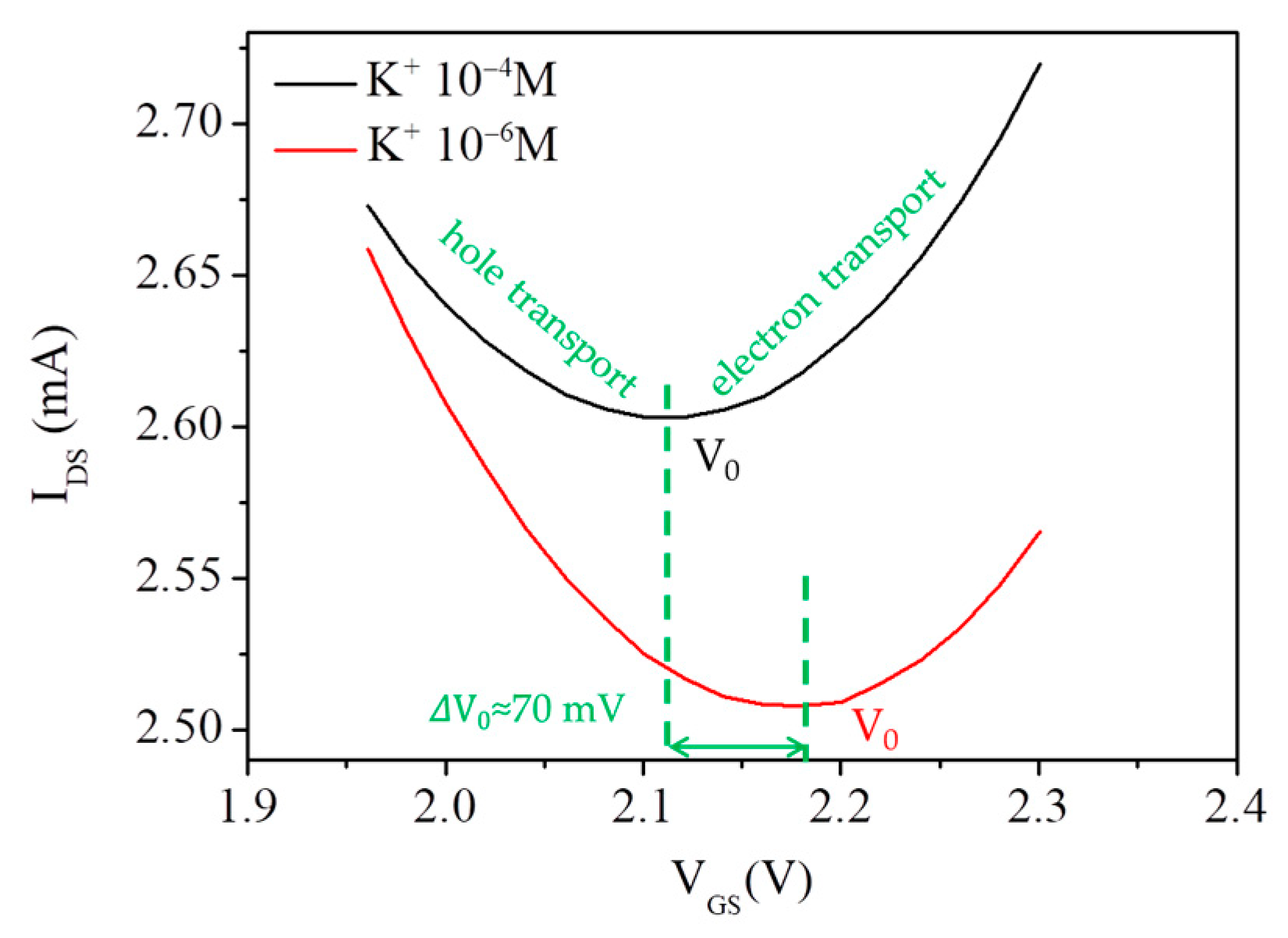A Complementary Reduced Graphene Oxide-Based Inverter for Ion Sensing †
Abstract
:1. Introduction
2. Materials and Method
3. Results and Discussion
3.1. Electrical Characteristics of the EG-GFET Inverter
3.2. The EG-GFET Inverter as K+ Sensor
4. Conclusions
Author Contributions
Funding
Institutional Review Board Statement
Informed Consent Statement
Acknowledgments
Conflicts of Interest
References
- Hess, L.H.; Seifert, M.; Garrido, J.A. Graphene Transistors for Bioelectronics. Proc. IEEE 2013, 101, 1780–1792. [Google Scholar] [CrossRef] [Green Version]
- Ohno, Y.; Maehashi, K.; Yamashiro, Y.; Matsumoto, K. Electrolyte-Gated Graphene Field-Effect Transistors for Detecting pH and Protein Adsorption. Nano Lett. 2009, 9, 3318–3322. [Google Scholar] [CrossRef] [PubMed]
- Kireev, D.; Brambach, M.; Seyock, S.; Maybeck, V.; Fu, W.; Wolfrum, B.; Offenhäusser, A. Graphene transistors for interfacing with cells: Towards a deeper understanding of liquid gating and sensitivity. Sci. Rep. 2017, 7, 6658. [Google Scholar] [CrossRef] [PubMed]
- Heller, I.; Chatoor, S.; Mannik, J.; Zevenbergen, M.A.; Dekker, C.; Lemay, S.G. Influence of Electrolyte Composition on Liquid-Gated Carbon Nanotube and Graphene Transistors. J. Am. Chem. Soc. 2010, 132, 17149–17156. [Google Scholar] [CrossRef] [PubMed]
- Furlan de Oliveira, R.; Livio, P.A.; Montes-García, V.; Ippolito, S.; Eredia, M.; Fanjul-Bolado, P.; Gonzalez Garcia, M.B.; Casalini, S.; Samorì, P. Liquid-Gated Transistors Based on Reduced Graphene Oxide for Flexible and Wearable Electronics. Adv. Funct. Mater. 2019, 29, 1905375. [Google Scholar] [CrossRef] [Green Version]
- Son, M.; Kim, H.; Jang, J.; Kim, S.Y.; Ki, H.C.; Lee, B.H.; Kim, I.S.; Ham, M.H. Low-Power Complementary Logic Circuit Using Polymer-Electrolyte-Gated Graphene Switching Devices. ACS Appl. Mater. Interfaces 2019, 11, 47247–47252. [Google Scholar] [CrossRef] [PubMed]
- Vasilijević, S.; Mattana, G.; Anquetin, G.; Battaglini, N.; Piro, B. Electrochemical tuning of reduced graphene oxide in printed electrolyte-gated transistors. Impact on charge transport properties. Electrochim. Acta 2021, 371, 137819. [Google Scholar] [CrossRef]
- Kisiel, A.; Kałuża, D.; Paterczyk, B.; Maksymiuk, K.; Michalska, A. Quantifying plasticizer leakage from ion-selective membranes—A nanosponge approach. Analyst 2020, 145, 2966–2974. [Google Scholar] [CrossRef] [PubMed]



Publisher’s Note: MDPI stays neutral with regard to jurisdictional claims in published maps and institutional affiliations. |
© 2022 by the authors. Licensee MDPI, Basel, Switzerland. This article is an open access article distributed under the terms and conditions of the Creative Commons Attribution (CC BY) license (https://creativecommons.org/licenses/by/4.0/).
Share and Cite
Boukraa, R.; Mattana, G.; Battaglini, N.; Piro, B. A Complementary Reduced Graphene Oxide-Based Inverter for Ion Sensing. Eng. Proc. 2022, 16, 2. https://doi.org/10.3390/IECB2022-12272
Boukraa R, Mattana G, Battaglini N, Piro B. A Complementary Reduced Graphene Oxide-Based Inverter for Ion Sensing. Engineering Proceedings. 2022; 16(1):2. https://doi.org/10.3390/IECB2022-12272
Chicago/Turabian StyleBoukraa, Rassen, Giorgio Mattana, Nicolas Battaglini, and Benoit Piro. 2022. "A Complementary Reduced Graphene Oxide-Based Inverter for Ion Sensing" Engineering Proceedings 16, no. 1: 2. https://doi.org/10.3390/IECB2022-12272
APA StyleBoukraa, R., Mattana, G., Battaglini, N., & Piro, B. (2022). A Complementary Reduced Graphene Oxide-Based Inverter for Ion Sensing. Engineering Proceedings, 16(1), 2. https://doi.org/10.3390/IECB2022-12272






